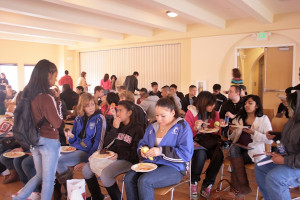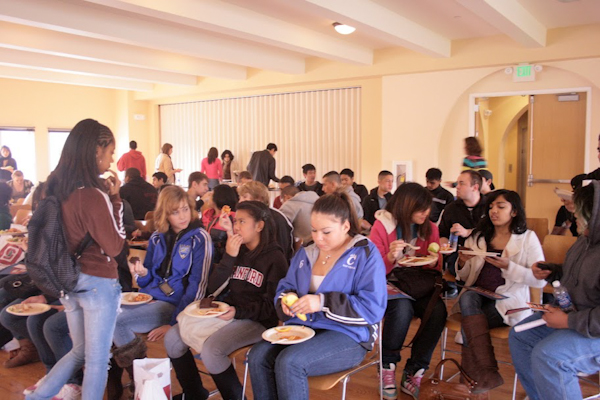A Mission High School freshman pushed his chair back and slowly stood up. After looking around hesitantly, he said, “I want to be a doctor one day. How do you become a doctor?”
He was part of a group consisting of 50 ninth-grade teachers and their students, all from immigrant or disadvantaged backgrounds. The group was gathered in a large conference room in the Center for Educational Research at Stanford (CERAS) for a panel on higher education hosted by Project Motivation.
Project Motivation is an on-campus organization founded in the 1970s that interacts and collaborates with minority high school students in the Bay Area to encourage the pursuit of higher education by minority youth.
The Stanford Teacher Education Program (STEP) co-hosted the event, which featured a panel of eight undergraduate and graduate students representing a range of ethnicities, academic interests and experiences, but all sharing one common bond–all came from an immigrant or refugee background.
The panelists provided advice and answered questions concerning both the college application process and college life. They especially focused on the need for students to pursue alternate forms of funding.

“Most of my friends did not go to college because they did not have the money,” remarked one panelist. Yet had they known about scholarships and financial aid, they could have attended, he added.
“College will make you more conscious of what is going on around the world,” said another panelist. “It will challenge you mentally, intellectually and personally.”
After the panel discussion, the students split into smaller Spanish- and Mandarin-speaking groups with Stanford students, allowing for a more intimate setting.
Brian Waldman, a ninth-grade teacher at Mission High School, praised the organization and its efforts.
“Not every one of these students will go to Stanford,” Waldman said, “but it puts the idea of college into their minds, and that’s the first step needed.”
Thanh Nguyen ’14, whose parents immigrated to the United States from Vietnam, is a volunteer at Project Motivation and was a panelist during the event. He warned the students of losing themselves in the college process.
“Do what you love and be authentic,” Nguyen said. “Too many students fall into the trap of doing what they think colleges want them to do.”
According to Nguyen, the most challenging aspect of his work is translating the idea of college into terms the students can understand, because it is often so markedly different from the education systems to which they are accustomed.
Ninth grader Jaz Lin, who recently immigrated with her family from the province of Guangdong in Southern China, echoed this sentiment.
“Stanford is an amazing school, and talking to these students makes me feel like if they can do it, I can do it,” Lin said. “But it is difficult to understand the college process and the system here.”
While Project Motivation typically hosts one to two tours and panel discussions per week, the organization also holds a biannual event, Day with an Undergraduate, which will take place on Feb. 21 and May 19 this year.
As part of this program, 40 to 60 middle-school students shadow Stanford undergraduates for a day in their classes, while also attending tours, panels, motivational speeches and performances. This year’s motivational speaker will be Michael Tubbs ’12, a first-generation college student from a disadvantaged background.
Projection Motivation is composed of 16 to 18 core members and 40 other participants. It is led by co-presidents Kaela Farrise ’14 and Kennan Murphy-Sierra ’14 and has subdivisions including volunteer coordination, logistics and external relations.
“We want to take the students on a more personal tour when we show them the campus,” Murphy-Sierra said. “It is not about the history and facts, but showing them what college is like.”
Murphy-Sierra points to a need for a reform in high school education.
“There are so many students who are not aware of what college is or why they should attend it,” he said.
According to Murphy-Sierra, although the organization does not have concrete numbers on “success rates,” teachers and students he has worked with have repeatedly contacted the group with positive feedback.
In an email to the organization, Krista Taylor, a high school counselor at the Bay Area School of Enterprise, praised the organization’s events.
“In 2010, I was able to bring a group of my students to attend Stanford Undergraduate for a Day, and I found it to be one of the most rewarding experiences for my students,” Taylor wrote.
Besides the difficulty in measuring “success rates,” Murphy-Sierra identified getting busy Stanford students to volunteer, especially during the midterm season, as a major challenge.
Looking to the future, Project Motivation is considering a one-on-one mentoring program to offer more personalized attention and guidance to the participating students. The group also hopes to encourage more Stanford students to volunteer their time to give back.
“College has opened a lot of possibilities I never thought were available,” Nguyen said, reflecting on his experience with the group. “When you come to Stanford you create yourself, and nobody tells you who you are, and it’s very liberating. I want the same thing for these students too.”
